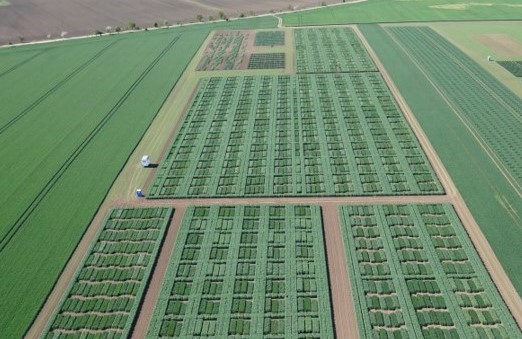Nutzung der Wechselwirkungen zwischen Genotyp, Standort, Jahr und Bewirtschaftung für eine nachhaltige Pflanzenproduktion
Dieser Use Case befasst sich mit den Herausforderungen in der Züchtung von Nutzpflanzen und wird Möglichkeiten zum Aufbau der erforderlichen Datenmanagementprozesse nutzen, die Interaktionen zwischen Genotyp, Standort, Jahr und Management ermöglichen.
Partner:
Leibniz Institute of Plant Genetics and Crop Plant Research (IPK)
Uni Hohenheim

Der Hintergrund
In der gegenwärtigen Züchtungspraxis werden krankheitsresistente und ertragsstabile Sorten für die Pflanzenproduktion ausgewählt, die in Feldversuchen mit mehreren Umwelteinflüssen einen hohen Durchschnittsertrag und ausgezeichnete Qualitätsmerkmale aufweisen. Bei diesem Verfahren liegt der Schwerpunkt ganz auf der Skala „Genetik“, und die Versuchsumgebungen werden bei der Zulassung der Sorten den lokalen Produktionstechniken in Bezug auf Düngung und Pflanzenschutz unterworfen. Umwelt- und Bewirtschaftungsparameter werden in statistischen Modellen als Rauschparameter betrachtet. Erst in späteren Stadien, z. B. bei regionalen Sortenversuchen oder detaillierten Versuchen in Züchtungsunternehmen, erfolgt eine Bewertung der spezifischen Sorteneignung für einzelne Umwelten und Empfehlungen für eine optimale Bewirtschaftung. Diese „One-size-fits-all“-Strategie ist jedoch nicht geeignet, um lokal angepasste Sorten zu entwickeln, die die Wechselwirkungen „Genotyp × Standort × Jahr × Bewirtschaftung“ berücksichtigen, um den Anforderungen einer zukünftigen nachhaltigen Pflanzenproduktion gerecht zu werden. Die Folge ist eine Kluft zwischen dem Selektionserfolg in experimentellen Umgebungen und in landwirtschaftlichen Betrieben. Eine Möglichkeit, diesen Engpass zu überwinden, besteht darin, unser Verständnis der Wechselwirkungen zwischen Genotyp, Standort, Jahr und Bewirtschaftung zu vertiefen und Vorhersagemodelle zu entwickeln, die Daten aus verschiedenen Bereichen integrieren, d. h. Parameter, die die Umwelt (z. B. Bodeneigenschaften, Niederschlag, Temperatur und pflanzenverfügbares Wasser), die Bewirtschaftung (z. B. Düngung und Pestizideinsatz) und die Genetik beschreiben. Die integrierte Nutzung von Genotyp-, Umwelt- und Anbaudaten wird derzeit durch die mangelnde Verfügbarkeit umfassender kuratierter Daten behindert.
Die Ziele
Das Hauptziel dieses Use Case ist der Aufbau der erforderlichen Datenverwaltungsprozesse und des Prototyps eines Analyse-Workflows, der wissensbasierte Vorhersagemodelle unter Berücksichtigung der Wechselwirkungen zwischen Genotyp, Standort, Jahr und Bewirtschaftung von Kulturpflanzen ermöglicht. Daten zu Umweltparametern, Wetterdaten, Versuchsplanung, Genetik von Sorten und wichtigen agronomischen Merkmalen werden kuratiert, harmonisiert, gespeichert und in einer FAIRagro-Infrastruktur zur Verfügung gestellt. Die Daten werden von öffentlichen Laboratorien mit Schwerpunkt auf Versuchsfeldstationen bereitgestellt. Die erwarteten Ergebnisse werden eine umfassende und kontinuierliche Nutzung von Datenquellen ermöglichen, die für die Nutzung von Wechselwirkungen zwischen Genotyp, Standort, Jahr und Bewirtschaftung für eine nachhaltige Pflanzenproduktion erforderlich sind.

